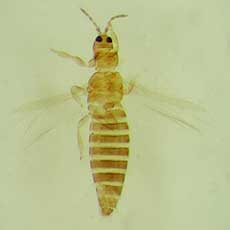
Male small and yellow; tergite VIII with marginal comb represented by a few irregular microtrichia; tergite IX B1 & B2 setae arising on a transverse straight line; sternites III–V with narrow transverse glandular area.
Thrips tabaci Lindeman, 1888
| Biology | |
| This common pest species breeds in the flowers and on the leaves of a wide range of plants, but it also feeds on the larvae of other thrips and of mites. Some populations are important as tospovirus vectors on various crops, including lettuce and potatoes in Tasmania and tobacco in Europe. |  |
| Distribution | |
| Cosmopolitan, but rare in the wet tropics. | |
| Recognition | |
| Female
macropterous; body varying in colour from yellow to dark brown; ocellar
pigment never red, usually grey; antennal segments III & IV brown
with basal half pale; forewings pale. Antennae 7-segmented, III & IV
slightly constricted at apex with short forked sense cone; VII short.
Head wider than long, with 2 pairs of ocellar setae; pair III small and
arising on anterior margins of ocellar triangle or just within the tangent
to the external margins of the ocelli; postocular setae
pairs I–III about equal to ocellar setae III in length. Pronotum
with 2 pairs of posteroangular setae; posterior margin with 3 (or 4)
pairs of setae. Metanotum irregularly reticulate medially with lines
converging to midpoint of posterior margin; median setae short and arising
behind anterior margin; campaniform sensilla absent. Mesofurca with spinula.
Forewing first vein usually with 4 (2–6) setae on distal half,
second vein with row of about 15 setae. Tergite II with 3 lateral marginal
setae; V–VIII with ctenidia present laterally, on VIII posteromesad
to spiracles; posterior margin of VIII with complete comb of long slender
microtrichia; pleurotergites without discal setae but with sculpture
of rows of fine microtrichia. Sternite II with 2 pairs of marginal setae,
III–VII with 3 pairs, the median pair on VII arising in front of
margin; sternites without discal setae. Male small and yellow; tergite VIII with marginal comb represented by a few irregular microtrichia; tergite IX B1 & B2 setae arising on a transverse straight line; sternites III–V with narrow transverse glandular area. |
|
| Related species | |
| The closely spaced rows of microtrichia on the pleurotergites, and the presence of similar microtrichia laterally on the tergites, are highly distinctive for Thrips tabaci. Moreover, in life the species can usually be recognised because the ocelli have grey pigment, rather than usual red pigments. The body colour varying from yellow to brown, is related to the temperatures during development (Murai & Toda, 2002). | |